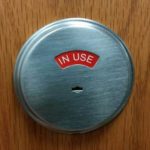 I recently heard from an architect who was looking for an occupied indicator for a family restroom – indicators are required by code for these restrooms as well as for assisted-use restrooms. The architect was asking about adding an indicator deadbolt to a door with an existing privacy set, which would require a second releasing motion. (This isn’t currently allowed by code but stay tuned for a possible change.)
I recently heard from an architect who was looking for an occupied indicator for a family restroom – indicators are required by code for these restrooms as well as for assisted-use restrooms. The architect was asking about adding an indicator deadbolt to a door with an existing privacy set, which would require a second releasing motion. (This isn’t currently allowed by code but stay tuned for a possible change.)
I was surprised to hear that the architect didn’t know about the new cylindrical indicator locksets and latchsets from Schlage. Several months back, Mark Kuhn wrote a post about where indicators are recommended or required. In addition to the indicators required by code for some restrooms, double-cylinder deadbolts used on the main entrance of a building or tenant space, or on a door serving an enclosed courtyard or roof terrace must be “readily distinguishable as locked.” Indicators are perfect for these applications.
There are other locations where indicators may not be required by code, but are very beneficial for security or privacy. Classrooms are a great example, as the indicator will show teachers and students when the door is locked. Knowing that the door is secure can be helpful in schools where classroom doors are kept locked at all times, and also when a school goes into lockdown. Egress is not affected when the door is locked.
To help spread the word about the indicator options available from Allegion for locksets and panic hardware, I’m sharing some resources where you can find more information, including the overview video below.
Any questions? Leave them in the comment box!
You need to login or register to bookmark/favorite this content.










I like the good size, of the indicator!!!
https://www.indicatordeadbolt.com/
When we’re installing a low-energy door operator on single-occupancy restrooms, we’ve started using a privacy indicator deadbolt, along with a latchbolt monitor (Securitron LML–1) to disable activation. This works really well! The Schlage B571 WAS my go-to deadbolt, but it’s been discontinued in favor of the new design. Unfortunately the new deadbolt is double the price. The new design definitely works better.
The Restroom Up LoK is the original restroom privacy lock with a clear locked status indicator on BOTH sides of the door.